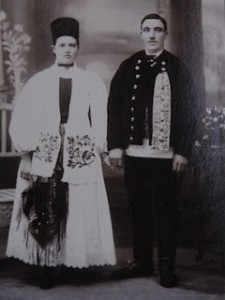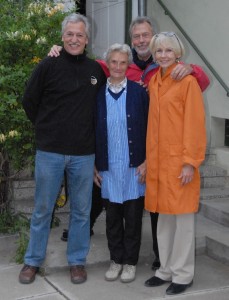
Maria Schuster marries Samuel Ebner May 22, 1899
recorded in the Church “Family Book” in Grosspold, Romania
Samuel Ebner, my great-grandfather, did not remain a widower for long (see how my great-grandmother died at Life and Death Abbreviated). In May 1899, he married the widow, Maria Schuster, who brought at least two daughters into the marriage, creating what we call today a “blended family.”
The bottom of the Samuel Ebner page in the “Grosspold Family Book,” shown above, records the marriage. Maria Schuster (née Wagner) was thirty-two when she and Samuel married. It may have had as much to do with practicality as love. Each had suffered the loss of a spouse. Each had children to raise. Joining together made sense, but Lisi, Samuel’s daughter and my grandmother, felt abandoned a second time.
She wanted her father all to herself and felt she was losing him to this unknown woman. The same dynamics that affect blended families today—children not accepting the new step-parent, resentment, parental loss still palpable—those feelings existed just as strongly 100 years ago.
A neighbor took Lisi aside, we later heard, and in trying to convince her all was for the best, whispered, “A man needs a woman.” Twelve at the time, Lisi probably missed the sexual connotation of this remark, but never forgot it.
Just like today, it probably took a lot of patience and love for Maria Schuster as the step-mom to win over Lisi, but she did—and Lisi came to love her new mother and sisters as her own. Difficult times and a strong community code that encouraged families to stay together probably helped, but I believe unconditional love was at the root of this blended family’s success.

Agnetha Schuster), left, my grandmother’s step-sister. Wedding photo
Two new children were born to Samuel and Maria: Theresia, known as Resi, in 1900 and Johan, called Hans, in 1904. But the sisters brought into the marriage remained a mystery—until our family trip to Romania in 2007.
In searching for my great-grandfather’s house in Grosspold, Pastor Meitert met a woman he wanted to introduce us to, Elisabeth Kirschlager. We were puzzled about her connection to our family—until she produced a familiar photograph—one I had puzzled over many times in our family collection because it was unlabeled. This is the photo Elisabeth Kirschlager showed us: her grandmother’s wedding photo. As we struggled through the language barrier, it suddenly became clear: Elisabeth Kirschlager’s grandmother was one of the daughters brought into the new marriage—and grew up side by side with my grandmother.

Elisabeth Kirschlager center
L-R Bill, Paul, Linda Gartz 2007
I spontaneously threw my arms around Elisabeth and cried. Though not related by blood, we shared a common family past through our grandmothers. It was a breakthrough in understanding the connection of family that goes beyond genes. Blended families know these bonds are as strong and true today as they were a century ago.
Next: Lisi’s third mother.



Linda,Thank you for bringing so many beautiful words and pictures to life through your blog. You’ve certainly been working hard…and you’ve accomplished SO MUCH in such a short amount of time. Bravo! As someone from a blended family, I can’t thank you enough for such a beautiful description of what it feels like: “I spontaneously threw my arms around Elisabeth and cried. Though not related by blood, we shared a common family past through our grandmothers. It was a breakthrough in understanding the connection of family that goes beyond genes. Blended families know these bonds are as strong and true… Read more »
Christine!
So great to think that this post touched a cord in you. I hope to reach someone with all these posts. I’m using my family as a jumping off point, but I want to make a connection with the human experience. Thanks for writing!